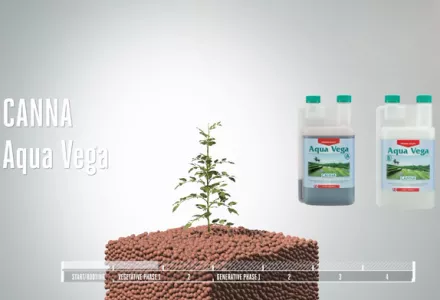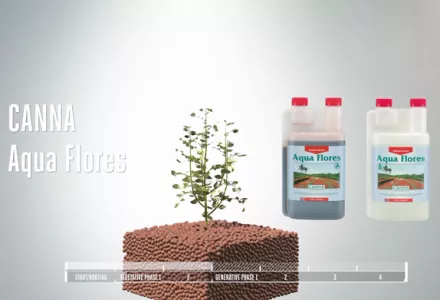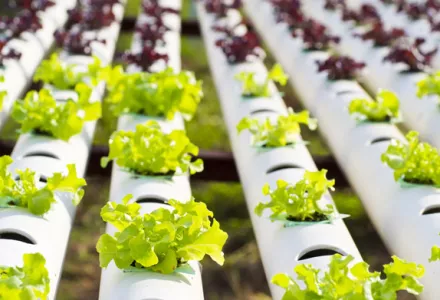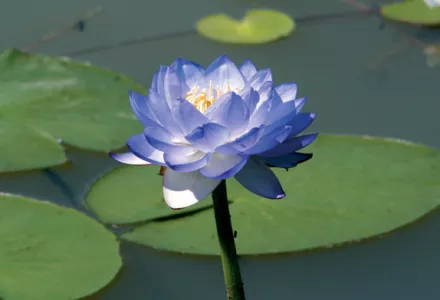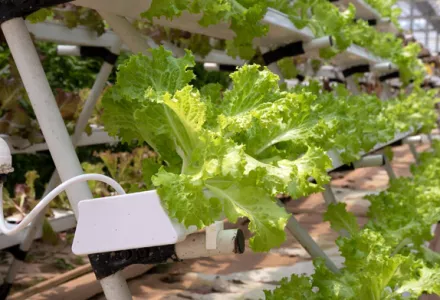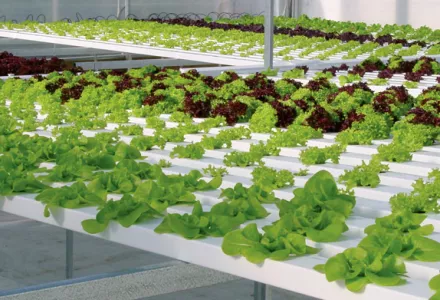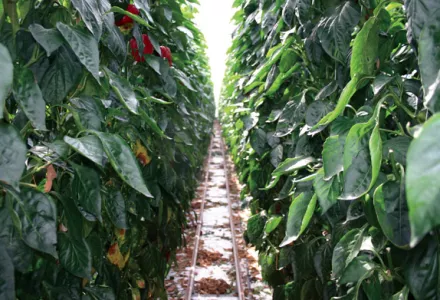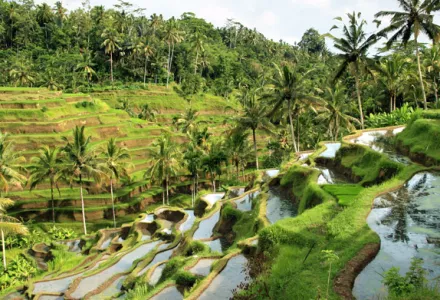Aquaponics is essentially organic cultivation of plants and animals together in a re-circulating closed system (water tank), using water instead of potting mixes. Technically speaking it is a combination of aquaculture (fish farming) and hydroponics (soil-less plant culture). Although there are currently a limited number of commercial aquaponic operators, many people are expressing a strong interest in this intensive method of food production.
Plant cuttings can be composted in a wormery (simplest definition is a container that holds worms and is used to compost) to provide food for the fish. The nutrient-rich water that results from a build-up of fish waste (feces, urine and urea) which can become toxic to the fish are converted by beneficial bacteria in the water into nitrites and then harmless nitrates which are used by plants as a natural fertiliser. As the plants consume these nutrients, they help to filter the water that the fish live in. The clean water is returned to the aquatic animal environment and the cycle continues. It is a closed loop system with minimum impact on the environment. The system produces fast growing and succulent vegetable and fruit crops while also providing fish. Aquaponics is a sustainable, fun and simple way to produce excellent quality food for your community or for sale commercially.
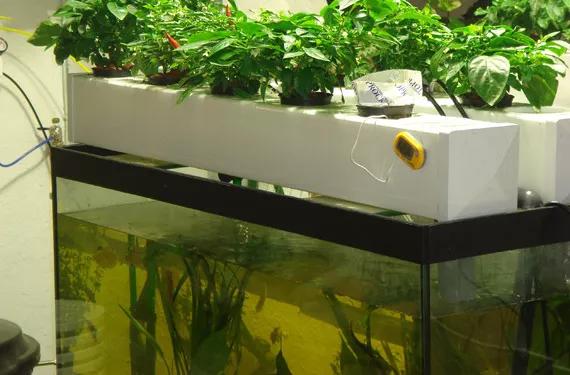
The system relies on the smooth functioning of the natural ecosystem created in the water tank. Water is only added to replace water loss from absorption by plants, evaporation into the air or the removal of biomass from the system.
This system is efficient, uses up little space and does not require lots of extra water. The fish provide all the nutrients needed by the plants so no fertiliser is required. Because the plants grow in water there are no weeds and so herbicide is not needed either. The daily water use is minimal and a large volume of food crops can be grown using much less space when compared to growing crops in a field. Aquaponics can be produced locally, year round and with consistent cropping. Aquaponics can be set up in urban areas supplying food to local markets, in dry regions with poor soil, in developing countries, in rural communities or anywhere else that fresh food is needed.
Aquaponic systems vary in size, from small indoor units to large commercial units. They can use fresh or salt water depending on the type of aquatic animal and vegetation being grown. Aquaponics has the potential to provide a profitable and sustainable business especially for the production of high-value crops to a network of established outlets. It cannot compete on a wholesale level with commercial hydroponics, or with intensive aquaculture, but aquaponics fulfills a niche market of sustainable local food production.
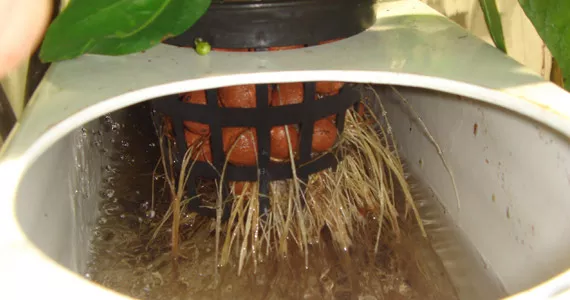
Hydroponics methods used
1. Deep Water Circulation (DWC) or Floating Raft Culture
This is used with large-scale systems, where there is an extensive crop area and high levels of fish stocks. Plants are grown in a media such as rock wool or coir and are then transplanted into net pots which fit into holes cut out of a floating polystyrene raft. The polystyrene insulates the water and excludes light which reduces algal growth. The water is aerated by an air pump, compressor or regenerative blower to ensure the water is sufficiently oxygenated to allow the roots to assimilate the nutrients rather than simply rotting away.
2. Nutrient Film Technique (NFT)
A thin film of water is continually circulated down a gulley or gutter type system. Plants are then grown in pots which fit into holes in the NFT channels, bathed by a constant flow of nutrient-rich water.
3. Grow beds (media filled)
One of the simplest aquaponic methods in use is grow beds coupled with fish tanks and a pumped flow. Grow beds can be filled with lightweight clay balls (lightweight, pH buffered, and aids in aeration) or gravel (lower cost alternative). Standpipes, auto-siphons and pre-filters can all be incorporated into the design where appropriate.
The key to looking after the aquaculture (fish) is to look after the water quality. Healthy fish stocks are maintained by making sure the water is clean, well aerated, at the correct temperature and adequate food is available for the fish. Careful husbandry and monitoring will ensure a productive and a stress-free environment for your fish and will ensure that they thrive and breed.
Lettuce, chives and other leafy crops were first considered for aquaponics but, more recently, commercial growers and researchers have had great success with tomatoes, cucumbers, peppers, melons, flowers, strawberries, and herbs (basil, mint, wheatgrass, chives, oregano, sage, parsley). Tilapia is a fresh water fish that is fast growing and has firm white meat when filleted. It is most commonly raised in aquaponics because it can tolerate a wide variety of water quality conditions. Other fish, such as crappie, brim, bass, carp, trout, goldfish and koi can also be raised in this system.
Advantages of aquaponic food production
- Uses the nutrient-rich water from aquaculture that otherwise would have been a waste product.
- Eliminates the cost and time involved in mixing traditional hydroponic nutrients.
- Provides a truly organic form of nutrients for the plants.
- Produces an organic product (no fertilizer or herbicides used).
- No soil-borne disease as there is no soil.
- No water is wasted or consumed by weeds.
- Relatively small spaces required as plant spacing can be intensive.
- Plants grow and develop relatively quickly.
- Crops can be grown all year-round. In most climates a greenhouse is required.
The number of fish you can stock in your tank depends on the size of the tank and the type of filtration system in use. In an aquarium-based system, stock the tank at 1" (of fish length) per 3.5 liters of water. In larger systems, commercial growers usually stock the tank to a maximum of 1/2 lb of fish per 3.5 liters of water.
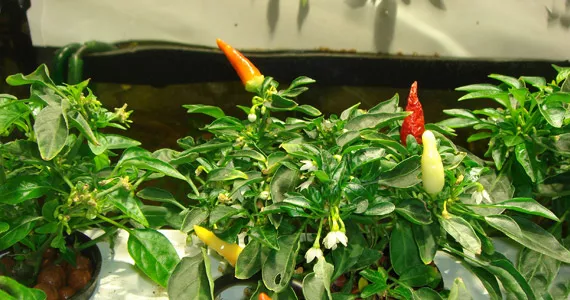
The number of plants you can grow depends on the number of fish in the tank, their relative size and the amount of fish food added daily. In general, 1 sq. meter of plants in raft Aquaponics can grow for every 60-100 grams of fish food added per day.
Commercially, aquaponics is still in its infancy but, as the technology develops and is refined, it has the potential to be a more efficient and space-saving method of growing fish, vegetables and herbs. Not everyone can make a success of this business – you must have the correct equipment, have the technical know-how to grow plants and raise fish, and be a good manager and marketing specialist!

